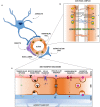Pathophysiology of Blood-Brain Barrier Permeability Throughout the Different Stages of Ischemic Stroke and Its Implication on Hemorrhagic Transformation and Recovery
- PMID: 33362697
- PMCID: PMC7756029
- DOI: 10.3389/fneur.2020.594672
Pathophysiology of Blood-Brain Barrier Permeability Throughout the Different Stages of Ischemic Stroke and Its Implication on Hemorrhagic Transformation and Recovery
Abstract
The blood-brain barrier (BBB) is a dynamic interface responsible for maintaining the central nervous system homeostasis. Its unique characteristics allow protecting the brain from unwanted compounds, but its impairment is involved in a vast number of pathological conditions. Disruption of the BBB and increase in its permeability are key in the development of several neurological diseases and have been extensively studied in stroke. Ischemic stroke is the most prevalent type of stroke and is characterized by a myriad of pathological events triggered by an arterial occlusion that can eventually lead to fatal outcomes such as hemorrhagic transformation (HT). BBB permeability seems to follow a multiphasic pattern throughout the different stroke stages that have been associated with distinct biological substrates. In the hyperacute stage, sudden hypoxia damages the BBB, leading to cytotoxic edema and increased permeability; in the acute stage, the neuroinflammatory response aggravates the BBB injury, leading to higher permeability and a consequent risk of HT that can be motivated by reperfusion therapy; in the subacute stage (1-3 weeks), repair mechanisms take place, especially neoangiogenesis. Immature vessels show leaky BBB, but this permeability has been associated with improved clinical recovery. In the chronic stage (>6 weeks), an increase of BBB restoration factors leads the barrier to start decreasing its permeability. Nonetheless, permeability will persist to some degree several weeks after injury. Understanding the mechanisms behind BBB dysregulation and HT pathophysiology could potentially help guide acute stroke care decisions and the development of new therapeutic targets; however, effective translation into clinical practice is still lacking. In this review, we will address the different pathological and physiological repair mechanisms involved in BBB permeability through the different stages of ischemic stroke and their role in the development of HT and stroke recovery.
Keywords: blood-brain barrier; hemorrhagic transformation; pathophysiology; permeability; stroke.
Copyright © 2020 Bernardo-Castro, Sousa, Brás, Cecília, Rodrigues, Almendra, Machado, Santo, Silva, Ferreira, Santana and Sargento-Freitas.
Conflict of interest statement
The authors declare that the research was conducted in the absence of any commercial or financial relationships that could be construed as a potential conflict of interest.
Figures



References
Publication types
LinkOut - more resources
Full Text Sources
Other Literature Sources

